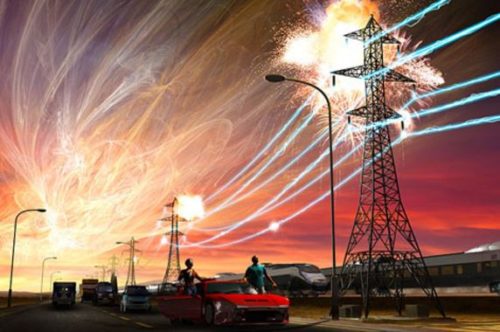
I am a sometimes-proud alumni of a little college located in Ann Arbor, as many of you know, and over a couple decades of deep disappointment, thought I had successfully weaned myself off the football program there.
Alsas, I regret to say that the antics of the young men in the Maize and Blue have sucked me in once more and I know not how they will endeavor to break my heart this year. But if the track record is to be believed, it will happen with the sort of monotonous repetition of all the seasons that have gone before.
Oh well. it will be fun while it lasts. As someone noted to me at The Front Page the other night, our coach is a certified lunatic. I responded that it was OK- “he is our lunatic.”
Anyway, that is not what got me started this morning. There was an announcement that my alma mater’s new algorithm for Space Weather Modeling had been selected by the National Space Weather Prediction Center for official forecasting. Sources tell me that space weather forecasts can provide alerts for when GPS navigation is unreliable, can help to prevent damage to communications satellites, and in extreme cases, prevent transformers from burning out and causing widespread, long-term power outages.
The deal on the latter is a large one: power transformers take months to build, and represent one of the components in the power grid for which there are no spares.
Most of us shrug at news of weather on the sun- but there have been a couple events over the last two centuries for which a cautionary tale can be told. Should be told, actually, since there is the real possibilitiy that we have an indecent possibility of having another event in our lifetimes. Not that we needed anything else to worry about.
At the link is a nice video about the likelihood of a “Carrington Event”- a massive solar storm- and what would happen should another one occur:
http://dme.engin.umich.edu/spaceweather/
According to NASA’s Spaceweather.com, a G1-class geomagnetic storm is ringing Earth’s poles today as a high-speed (600+ km/s) stream of solar wind continues to buffet our planet’s magnetic field. While this
particular storm isn’t expected to do more than produce spectacular Auroras and perhaps cause some minor power grid fluctuations, knowing what impacts a stronger solar storm could have is a very useful
thing. Solar storms can send harmful current into power lines, hampering operations and putting expensive transformers at risk.
Humans haven’t experienced a catastrophic solar storm since we began to string wires to transmit power and communications. The “Carrington Event” that struck the Earth in September 1859 was observed by
English astronomer Richard C. Carringon. Even though only telegraph lines spanned the planet, the event was a doozy. It produced Auroras seen around the world, from the northern hemisphere to as far south
as the Caribbean; those over the Rocky Mountains were so bright that the glow awoke gold miners, who began preparing breakfast because they thought it was morning. People on the eastern seaboard could
read newspapers by the light of the skies. The aurora was visible as far from the poles as Sub-Saharan Africa, Mexico, Australia, Cubaand Hawaii.
That was the spectacular visual aspect of the storm. Telegraph communications all over Europe and North America failed as transmission pylons arced with sparks. Some operators could continue to send and receive messages despite having disconnected the power supply to their keying devices. Considering how we depend on overhead lines to transmit our power and phone calls, and the vulnerable satellites we use to move data around all the sectors of our economy, the implications get as interesting as the concept of using Eletromagnetic Pulse to wipe out an adversary nation with a nuke.
OK- so here is the good part: some solar observers estimate there is a better than 10% chance that Earth could be hit with an extreme solar storm in the next decade. In 2012, a Carrington-scale ejection crossed Earth’s orbit and missed us by a week. That might have affected even an election that in many aspects looks just like a terrestrial Carrington Event. \
I am not going to worry about it overmuch; I mean, I think we are all on sensory overload as it is- but do suggest that you look at the video and get a feel for what things might be like should we get nailed and what you might want to keep handy, just in case. They say the largest storms occur after the solar maximum cycle of twenty-two years, so we are in the sweet spot for a storm. I try to keep several weeks worth of dried food at the farm, just in case. And enough gas in the tank of the Panzer to get there.
Assuming the storm does not fry the electronics in the vehicle. That would be interesting. In that case, I might have to steal a bike.
Copyright 2016 Vic Socotra
www.vicsocotra.com
